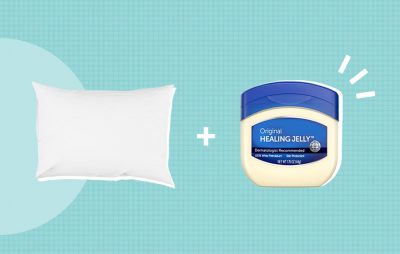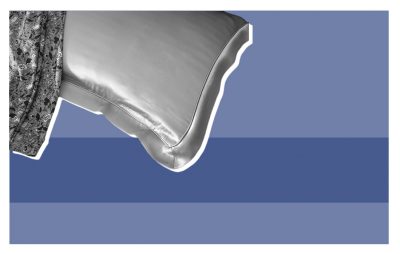Table of Contents
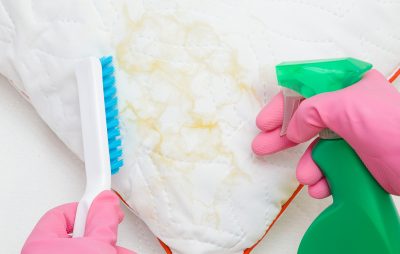
You might not always think about your pillows when washing your sheets and other bedding, but considering your pillow is where you lay your head every night to go to sleep, you might want to start thinking about it. Not to mention the possibility of getting stains or spills on your pillow — you’ll definitely want to know how to clean it then.
To help you out, we put together a comprehensive guide to cleaning pillows. If you’ve browsed around Sleepopolis at all, you probably already know there are tons of different kinds of pillows, so I’ll be covering as many as I can in this guide.
Of course, you should always check and see what the manufacturer of the pillow says. Many brands post care instructions on their websites and put them on the tags of the pillow, so that can also help you determine the best course of action for cleaning.

How to Clean Your Pillows
Now that you’ve checked the manufacturer’s care recommendations (if possible), let’s get into the cleaning.
Step 1: Remove Pillow Covers
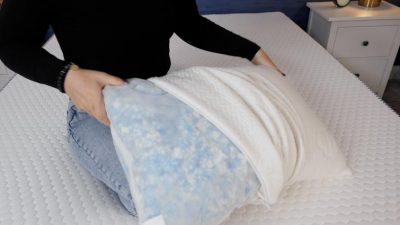
First things first, you’ll want to remove any pillow coverings. Take off any pillow cases or pillow protectors, as well as any removable pillow covers that came on the pillow. Not all pillows come with a cover, but many that are made with foam or adjustable fills have a cover that can be removed and washed.
If so, you’ll want to wash that cover according to the care instructions provided. Most can be machine washed in warm water with regular detergent, so you can toss it in with your sheets or other laundry if you so choose.
If your pillows don’t have removable covers, move along to step two.
Step 2: Let the Washing Begin
Now it’s time to actually get to washing your pillow. Because pillows can be made with so many different materials, it’s important to pick your washing method by pillow type to ensure you don’t damage your pillow. Let’s go over the best methods for cleaning each type of pillow.
Down
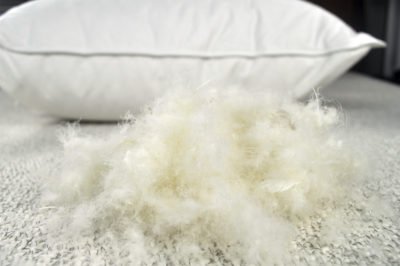
Down pillows are one of the more traditional styles of pillows available on the market. Down is the soft, fluffy feather layer under a bird’s tougher, exterior feathers and is commonly used in bedding, as well as products like winter coats and sleeping bags.
It might seem intimidating to wash down, as it is often expensive, but your down pillows are simple to wash. It’s best to wash your down pillows in a front-loading machine, as they may not become fully soaked in a top-loading machine. If you don’t have a front-loading washer at home, you may want to take your pillows to a laundromat.
Be sure to wash two pillows together, as one pillow alone may leave the washer unbalanced. If you don’t have two pillows, you can toss in a towel or small blanket to balance it out.
Use a mild, low-suds detergent, as you want to ensure there is no residual soap on the feathers inside your pillow. Run the washer on a gentle cycle with cold water.
If your down pillow has a small stain or spot you’d like to clean without having to wash the whole pillow, you can also spot-clean. In Martha Stewart’s Homekeeping Handbook, she recommends applying water to the stained area with an eye dropper, applying a small amount of mild detergent or baby shampoo with a clean toothbrush, sponging with warm water, and blotting with a clean towel.
Down Alternatives
Down alternatives follow a similar process as real down pillows, although perhaps less stressful, as most down alternatives are synthetic fibers, instead of delicate down feathers.
To wash down pillows, simply pop them in your washing machine and use a mild detergent. Again, you want to ensure the washer stays balanced, so wash two pillows together or add a towel to keep the weight distribution even.
Foam
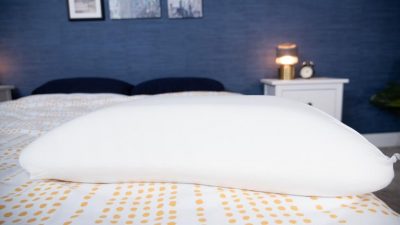
Memory foam is one of my favorite bedding materials, but one of its biggest cons is it can’t be washed. Foam pillows can either be a solid block of memory foam or can be shredded up pieces of foam. Both types will usually come with a cover.
Start by removing the pillow cover and washing according to the instructions. Most can be machine washed, so personally, I like to toss mine in the laundry with my sheets. However, some covers might be hand-wash only.
According to Renee Kraus of Renee’s Cleaning Services in Connecticut, if you have a foam block pillow, you can vacuum the foam with an upholstery attachment to remove any dust. She also recommends hanging the foam out on a sunny day to refresh it and kill any microorganisms.
If you have any spills or stains that you want to spot clean on the foam, you can use gentle laundry detergent and warm water to clean the area. Be gentle with the foam and don’t use any harsh cleaners, as they could damage the foam. Use a damp towel or rag to dab or rub the area with detergent until the stain comes out.
Shredded Foam Pillows
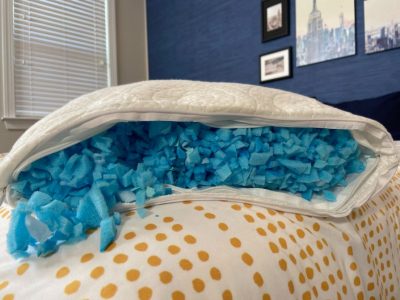
If you have a shredded memory foam pillow, the foam should all be contained in an inner chamber or pocket inside the pillow cover. Shredded memory foam pillows should not be put in a washing machine or dryer, as they can warp and crumble the foam.
I would recommend spot cleaning the fabric of the inner chamber or pocket if there are any visible stains with a damp towel and mild detergent. However, if you do want to wash the entire pillow, you can hand wash it in a sink or bathtub. If you choose this method, ensure you allow at least 24 hours for the pillow to air dry.
Fill the sink or tub with warm water and place the pillow in the water. Add your mild detergent and gently squeeze the pillow to work the detergent through. Use a small amount of detergent, as you don’t want residual soap stuck in your pillow.
After you’ve squeezed the pillow in the detergent and water a few times, take it out of the water and squeeze it again to get some of the moisture out. Don’t wring it or twist it — just squeeze. Then you’ll want to drain the water and refill your sink or tub with clean water. Repeat the same process of squeezing in the water and then out of the water to remove the soapy water.
Then, lay the pillow out to dry. Ideally, use a drying rack or something similar that will allow for ventilation.
Latex
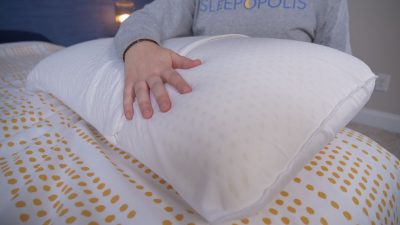
Latex foam is made from the sap derived from rubber trees. It is a popular alternative to memory foam, as it has a much bouncier feel and maintains a naturally cool temperature.
Like memory foam, latex foam cannot be washed. Follow the same procedure as with a memory foam pillow: remove the cover and wash separately, then vacuum the latex with an upholstery attachment and lay it out in the sun to kill any microorganisms. Spot clean the same as memory foam.
Buckwheat
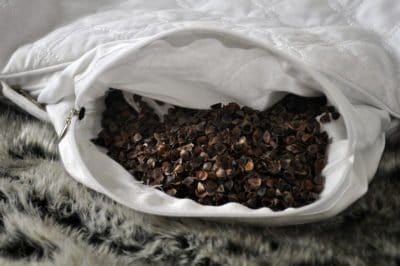
Buckwheat hulls are a natural filling used in pillows to provide a sturdy and moldable feel. But even if you love your buckwheat pillow, it’s not obvious how to clean a pillow filled with loose hulls.
Most buckwheat pillows have a pillow cover, so remove that and wash according to the instructions. For the actual hulls, Kraus advises emptying the buckwheat hulls into a bowl or sheet tray. She then advises placing the hulls out in the sunlight for a few hours to let them dry out, as they can collect moisture.
After a few hours, simply pour the hulls back into the cleaned and dried cover.
Kapok
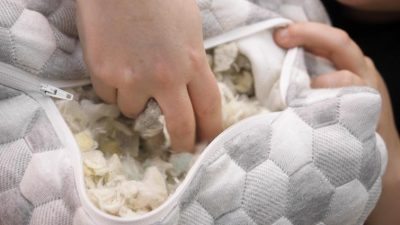
Kapok is another popular natural pillow filling. Kapok is the silky fiber from the seed pods of the silk cotton tree (Ceiba pentandra). Unfortunately, kapok is not washable, so if you have a kapok pillow, I would recommend following the same procedure as for a buckwheat pillow: wash the cover separately and place the fill in a bowl in the sunlight.
Cotton
While not extremely common, cotton-filled pillows are a soft and natural option that are available. To wash, Kraus recommends washing two cotton pillows together in the washer (or again, you can add towels to maintain the balance if you just have one pillow). Wash the pillows on a normal setting with a second rinse to ensure there is no detergent residue weighing the fibers down.
Wool
Like cotton, wool-filled pillows are not extremely common but are available. Like other styles of pillows, if it has a cover that can be removed and washed separately, do so according to the care instructions.
Kraus advises filling a basin with cool water and a small amount of wool detergent, then submerging the pillow in the basin and gently massaging it in the water. Once the pillow is completely saturated, empty the water and gently press water out of the pillow, but do not wring it. Try to get as much water out as you can.
Place the pillow in a clean bin and set it out in the sun. Fluff the wool as it is drying to break up any clumps that may have formed.
Step 3: Drying Your Pillow
Now that your pillow — whichever style you have — is clean, it’s time to dry.
For the pillow types that cannot be put in the dryer, set them out to dry somewhere well-ventilated or hang to dry. Memory foam (both block and shredded), latex foam, buckwheat, kapok, and wool should not be put in the dryer, as they could be damaged by the heat.
For the other types that can be dried in a dryer, including down, down alternatives, and cotton, place a couple of tennis balls or dryer balls in with the pillows to fluff them and break up any clumps.
With natural fillings, such as cotton and down, Kraus says to make sure the pillows are completely dry before use, as natural materials can mold if they are not fully dry.
Additionally for down pillows, it’s important to use a lower heat setting when drying, as the feathers can burn in too high of heat. If you smell burning, immediately end the cycle and start again at a lower heat.
Why You Should Wash Your Pillows
Even though most of us know to wash our sheets and bedding frequently, it might not be obvious that pillows need cleaning too. However, pillows can easily accumulate microbes and debris over time and since you rest your head on your pillow every night, it’s important to keep it clean.
Pillows don’t need to be cleaned as frequently as your other bedding, though. Pillows should be washed two to four times a year. Since it is an infrequent task, try to make a plan to start washing your pillows either quarterly or as a part of spring/fall cleaning so you don’t forget.
Dr. Jaimie DeRosa, a board-certified plastic surgeon based in Boston, advises using a pillow protector in addition to your pillowcase “to help form an extra barrier layer between the pillow itself and your dirty pillowcase.” That protector can be washed more frequently to ensure your pillow stays fresh.
Choosing a Cleaning Agent
For most types of pillows, a gentle or mild detergent is best. However, there are other cleaning agents out there. If you’re deciding what to use to clean your pillows, it’s important to be sure it’s safe to use on your pillow.
DeRosa says it’s important to use liquid detergent instead of powder when cleaning pillows, as the powder may not dissolve during the washing process. If the powder accumulates in the pillow, it could cause irritation to your skin.
She also cautions to be careful when choosing a spot-cleaning product. She says ammonium hydroxide is a common ingredient used in spot removers that is known to cause skin irritation, so that’s one you’ll definitely want to avoid.
If you know your skin is specifically sensitive to any cleaning products, she says you’ll definitely want to avoid using those on your pillow, since it is used so close to your face.
DeRosa says if you develop an itchy, red rash after contact with cleaning products, it is most likely contact dermatitis, which is a red and itchy rash caused by contact with an irritating substance or a substance that causes an allergic reaction. She recommends trying to determine what substance caused the reaction and avoid or minimize contact with it.
Final Thoughts
Your pillow is an important part of your bedroom setup, so make sure it gets the love it deserves by keeping it clean. If you’re on the hunt for a new pillow, be sure to check out our best pillows roundup for some of our favorite picks. Hopefully, no matter what style of pillow you choose, you’ll now be prepared to properly clean it.
Subscribe Today!
Get the latest deals, discounts, reviews, and giveaways!


